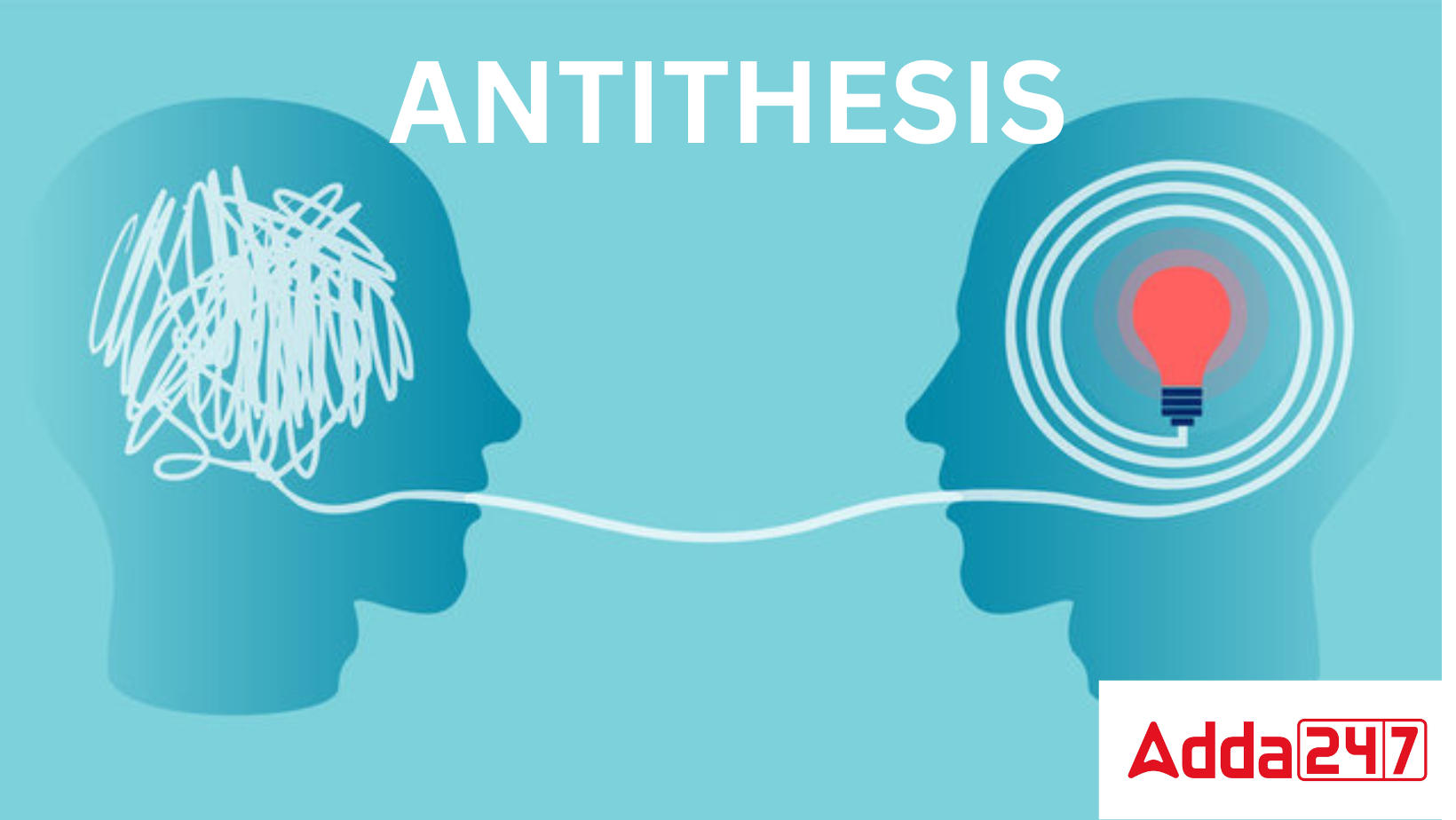Antithesis is a rhetorical device where two opposing ideas are placed in close proximity to highlight contrast and create impact. Commonly used in literature, speeches, and persuasive writing, antithesis draws attention to the differences between ideas, often enhancing clarity and strengthening an argument. This figure of speech is effective because it combines contrasting elements to present a balanced structure, making the comparison more vivid and memorable. For example, in the phrase “It was the best of times, it was the worst of times,” the contrast underscores conflicting emotions or scenarios, engaging readers or listeners through its dramatic opposition.
Antithesis Meaning
The word “antithesis” derives from a Greek root that means “opposition” and “set against.” Today, it’s frequently used to describe two concepts or expressions that are strongly opposed to one another. If we study the “Hegelian dialectic” in school, we can encounter antithesis. There, the thesis, or central notion of the argument, is opposed by its polar opposite, or antithesis, and the two are ultimately brought together in a third assertion, the synthesis. Without a thesis, since it serves as a point of comparison, an antithesis would not be possible.
Antithesis Definition
An antithesis is a figure of speech that presents two ideas that are drastically at odds with one another. They comprise compound sentences, typically with a comma or a semicolon separating the two independent clauses. The antithesis can also be a compound sentence with a conjunction, though this is less common. An antithesis is typically used to highlight the glaring contrast between two opposing viewpoints.
Define Antithesis
According to the Cambridge Dictionary, an antithesis is “a difference or opposition between two things,” and the Oxford Learner’s Dictionary defines it as “a contrast between two things.” A definition with further details can be found in the Merriam-Webster dictionary. The definition of antithesis given in that passage is “the rhetorical contrast of concepts through parallel groupings of words, clauses, or sentences.”
Antithesis vs Oxymoron
Understanding and efficiently utilising these rhetorical devices will be aided by your familiarity with the distinctions between an oxymoron and an antithesis. See the table below for further information.
|
Antithesis |
Oxymoron |
| Antithesis is a figure of speech that places two completely contrasting ideas or clauses in juxtaposition. | An oxymoron is a figure of speech that uses two words that are in opposition to one another or that contrast with one another to create a particular impact. |
| For example: “Art is long, and Time is fleeting.” | For example: “Why, then, O brawling love! O loving hate!” |
Antithesis Figure of Speech
The antithesis figure of speech might resemble the famous remark made by Neil Armstrong during the moon landing, “That’s one little stride for man and one big leap for mankind.” Because they are diametrically opposed to one another and yet contrast in the sentence, the modest step and gigantic step are the antitheses.
Antithesis Examples
Here are some of the most common examples of antithesis for your reference.
- Hope for the best; prepare for the worst.
- Keep your mouth closed and your eyes open.
- “It was the best of times, it was the worst of times. It was the age of wisdom, it was the age of foolishness.” – Charles Dickens
- “That’s one small step for a man, one giant leap for mankind.” – Neil Armstrong
- “Better to reign in Hell, than to serve in Heaven.” – John Milton
- Speech is silver, but silence is gold.
- “Give every man thy ear, but few thy voice.” – William Shakespeare
- Keep your friends close; keep your enemies closer.
- “To err is human; to forgive divine.” – Alexander Pope
- Money is the root of all evil: poverty is the fruit of all goodness.
Antithesis Examples of Proverbs
Here are some examples of proverbs featuring antithesis:
- Cleanliness is next to godliness.
- Beggars can’t be choosers.
- Easy come, easy go.
- Hope for the best; prepare for the worst.
- Keep your friends close; keep your enemies closer.
- Like father, like son.
- Where there’s smoke, there’s fire.
- An ounce of protection is worth a pound of cure.
- Be slow in choosing, but slower in changing.
- Give them an inch and they’ll take a mile.
- If you can’t beat them, join them.
- Keep your mouth closed and your eyes open.
- One man’s junk is another man’s treasure.
- Out of sight, out of mind.
- Where there’s a will, there’s a way.
Examples of Antithesis in Literature
Many authors have used antithesis in their work in order to provide the reader with a thought-provoking, contrasting statement. We are now going to take a look at some examples of times when writers have used antithesis within poetry, fiction and other types of written work.
- A tale of two cities by Charles Dickens opens with the use of antithesis in the line “Twas the very best in times, Twas the very worst in times. That was a time of wisdom and yet a time of foolishness.” In this example, antithesis is used to imply the conflict of the time in which the story was set.
- “To err is human, to forgive is divine,” This is a line from the play Julius Caesar written by William Shakespeare. Here antithesis is used to refer to the fact that God the creator is forgiving yet he created a race of humans who were far from perfect.
- In the poem ‘community’ written by John Donne, we see the use of antithesis to compare love and hate. “Good we must love and must hate ill.“
- Paradise lost written by John Milton features the use of antithesis when it compares the opposing ideas of heaven and hell alongside the opposing ideas of serving and reigning, in the sentence: “It is better to reign in hell than to serve in heaven.“
- In the Holy Bible, we see the use of antithesis in the book of Matthew, where we can read the line “many are called but few are chosen.”
- “Give me a bit of sunshine, give me a bit of rain.” This is an example of antithesis from the song Give me some sunshine by Swanand Kirkire. The notion of wanting sunshine is completely opposite to the idea of wanting rain and yet both are contained within the same sentence.
- In the song “My girl” by the band The Temptations we see antithesis being used in the line “When it is cold outside, I have got the month of May.”
- “In my beginning is my end.” This is an example of the use of antithesis within the poem Four Quartets which was written by T S Elliot.
- In the comic book featuring the character Green Lantern, an oath is written and the first line of this oath contains antithesis. “In the brightest of days and in the blackest of nights.
Antithesis Examples Figures of Speech
Antithesis is a figure of speech where contrasting ideas are placed in parallel structures to highlight their differences. Here are ten examples of antithesis:
“It was the best of times, it was the worst of times.”
(Charles Dickens, A Tale of Two Cities)
“To err is human; to forgive, divine.”
(Alexander Pope)
“Give every man thy ear, but few thy voice.”
(William Shakespeare, Hamlet)
“Speech is silver, but silence is golden.”
“That’s one small step for man, one giant leap for mankind.”
(Neil Armstrong)
“Love is an ideal thing, marriage a real thing.”
(Goethe)
“Many are called, but few are chosen.”
(Matthew 22:14, Bible)
“Patience is bitter, but its fruit is sweet.”
(Aristotle)
“Man proposes, God disposes.”
(Thomas à Kempis)
“You’re easy on the eyes, hard on the heart.”









 Try CUET College Predictor 2025 to Predi...
Try CUET College Predictor 2025 to Predi...
 CUET Result 2025 OUT (Today) @cuet.nta.n...
CUET Result 2025 OUT (Today) @cuet.nta.n...
 Why the Delay in CUET UG 2025 Results? C...
Why the Delay in CUET UG 2025 Results? C...









